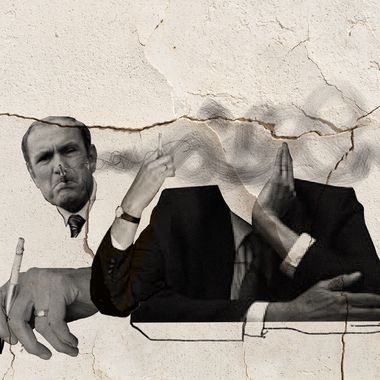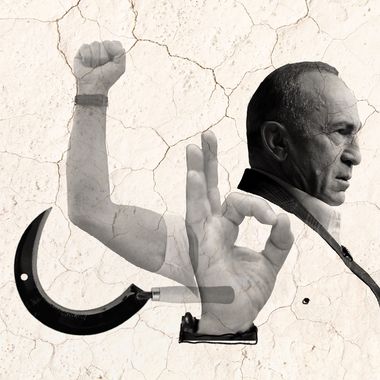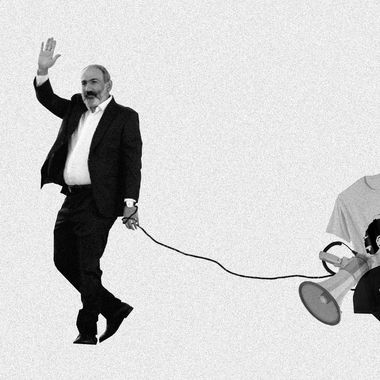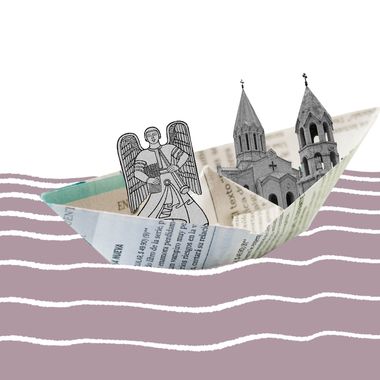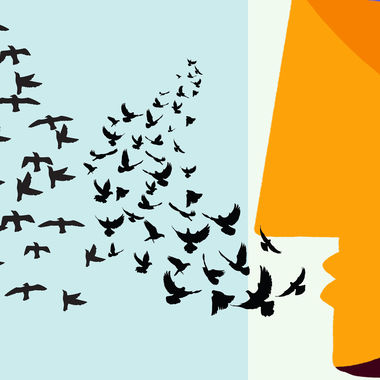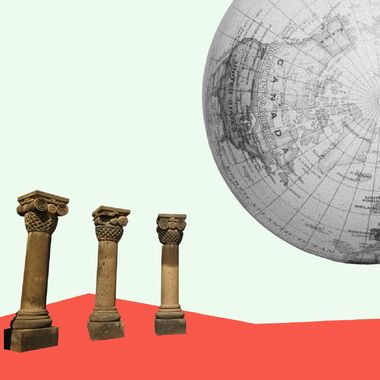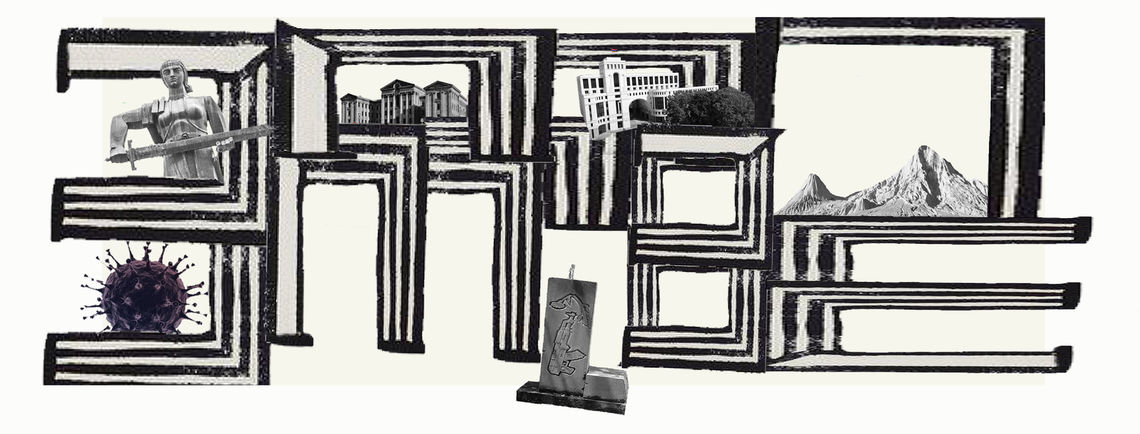
In September 2021, the High Commissioner’s Office for Diaspora Affairs announced the second iteration of its iGorts program, which attracts dozens of Armenian professionals from around the world, eager to share their skills in several ministries and offices of the Republic of Armenia. Although small in scope, this laudable, little-publicized initiative has a revolutionary dimension: for the first time, the Armenian state is establishing an organic and horizontal relationship with the diaspora. Until now, the links between Yerevan and Armenian diasporan communities around the world have been based primarily on two pillars: humanitarianism and philanthropy on the one hand, and tourism (memorial or recreation) on the other.
Since the 1988 earthquake, it has been clear that the mobilization of the diaspora in favor of Armenia has taken place intermittently on a transnational scale every time a tragedy rocks the motherland. This was the case at the time of the earthquake, which opened the doors of the Iron Curtain, the First Nagorno-Karabakh War, and the 2020 Artsakh War, which gave rise to a "digital diaspora". But there are gaping flaws in this relationship.
A Shaky Relationship With Strategic Potential
Though it generated immense enthusiasm, Armenia’s independence occurred in a chaotic context as war, shortages and an energy crisis gripped the nation. In those crucial first years, however, Levon Ter-Petrosyan’s new government did not reach out to the global diaspora to determine their role and responsibility in the state-building process. Instead, he embarked on an open conflict with the Armenian Revolutionary Federation (ARF), which had organized the largest diasporan network, eventually banning the party. The establishment of the Hayastan All-Armenian Fund met the most urgent needs; it made it possible to channel and professionalize aid without triggering impact investments in other sectors of the economy. However, the independence for which the political organizations of the diaspora were not prepared, still fearing an attack by Turkey, reset the paradigm of the Armenia-Diaspora relationship. Until then, the link to Armenia had been established through an intermediary, be it the Soviet-era Diaspora Committee or pro-Soviet Armenia community structures in the diaspora. Inaugurated in 1957, the first trips to Soviet Armenia under the restrictive framework of the Intourist agency were still heavily controlled into the 1980s.
Independence also changed the model of the Armenian diaspora: we went from a Stateless Diaspora (like that of the Palestinians, Kurds and Assyrians) to a State-Linked Diaspora (like that of the Jews, Irish and Lebanese).[1] However, unlike other countries with a strong diasporan tradition, such as Ireland, Greece and Portugal, Armenia did not establish—during the first 20 years of its independence—a consultative body or a political institution devoted to its nationals or compatriots beyond its borders.
In the 1990s, in the absence of legislation allowing dual citizenship, an intermediate accommodation was created in the granting of 10-year residence permits to diasporans. The hesitancy to welcome diasporans as citizens (without requiring them to renounce their ties to their country of birth) was grounded in the Ter-Petrosyan administration’s desire to restrict the political power of the ARF. His successor Robert Kocharyan was more open to the organization and lifted the ban on the ARF. He also appointed Vartan Oskanian, an Armenian-American from Syria, as Foreign Affairs Minister. Eager to attract investment, he organized the first major Pan-Armenian Diaspora conference in 1999, which did not lead to anything concrete except for grand declarations of little substance. At that time, the Armenia-Diaspora relationship was headed by the Foreign Ministry. There was an agreed-upon "division of labor" where the diaspora focused on the fight for international recognition of the Armenian Genocide, while the state piloted the internal affairs of the country without interference from Armenians abroad.
Serzh Sargsyan, who came to power amid the tragedy of March 1, 2008, was the one who set up a Ministry of Diaspora, which he entrusted to Hranush Hakobyan, a former Komsomol leader who had little knowledge of the realities within diasporan Armenian communities. Its policy was inspired by the Soviet-era Diaspora Committee. Practicing a discourse imbued with an old-fashioned patriotism, she developed several programs to create synergies among different professions (doctors, writers, journalists, jewelers, etc.). Her ministry played a significant role in accompanying and supporting the tens of thousands of Armenians from Iraq and Syria who settled in Armenia fleeing war.
The Velvet Revolution brought about a cosmetic change and a profound rejuvenation of the ministry. Born in 1990, Mkhitar Hayrapetyan was only 28 years old when he succeeded Hranush Hakobyan. While he ignored the complexity of diasporan Armenian communities, he was inspired by the Israeli model of Start-Up Nation and wanted to believe with his team that Armenia can attract young entrepreneurs from the diaspora. For this, he developed what will be one of his best successes: the Neruzh program. But the ultimate abolition of the ministry and its replacement by a High Commissioner’s Office reflects budgetary constraints and the little consideration that Nikol Pashinyan gives to the strategic dimension of the diaspora.
From Charity to Engagement
In 30 years, Armenia has become a "tourist homeland" in the eyes of many visitors from across the Atlantic and Europe. Many diasporans view Armenia as a place to do humanitarian work in villages or to be baptized in a monastery in Syunik or Artsakh and that’s where the engagement begins and ends. Philanthropy remains at the heart of the relationship, led by certain foundations (AGBU, Aznavour Foundation, Howard Karagheusian Foundation, Lincy Foundation, Cafesjian Family Foundation, COAF, etc.), but the absence of foresight and consultation between the actors in Armenia and the diaspora deprives these dynamics of their strategic significance. A mutual disinterest on essential subjects (socio-economic development and demographic security, cyber security, etc.) leaves most work related to the international recognition of the genocide (we are not talking about reparations claims) and Artsakh. The other effect of this mutual ignorance has resulted in two neglected areas: diasporan institutions themselves and diasporan studies in Armenia. Lack of interest in diasporan studies in Armenia and in the world outside of anthropology or an ideological approach focused on the idea of conserving Armenian identity [hayapahpanum]. With the exception of the Diaspora Center at Haigazian University in Beirut, which mainly focuses on Middle Eastern communities, there are no research centers worthy of the name to date.[2]
Philanthropy is not enough, just as the Armenian Virtual College at AGBU will not compensate for the loss of Melkonian High School in Cyprus.
What About the Traditional Parties?
While the diaspora as a deterritorialized political entity has never fully realized itself, it has missed important dates with history. In 1988, the three traditional parties expressed opposition to independence, fearing that Armenia could not face the Pan-Turkic danger on its own.[3] As for the role of traditional political parties, time has shown that their programs have not been successful. Non-existent in the diaspora apart from a few associations, the Hnchaks have no audience in Armenia. The Ramgavars have suffered from multiple splits but retain a certain renown among the Armenian intelligentsia thanks mainly to its unofficial organ, the Azg daily newspaper. As for the ARF, decades of compromise with the kleptocratic regimes of Kocharyan and Sargsyan, led to the failure of many of its foundational principles. Driven out of power by the Velvet Revolution, they later aligned themselves with Kocharyan’s Armenia Alliance in the June 2021 parliamentary election. But in the same way that the Hnchaks served as a conduit for Soviet power in the diaspora, the ARF went astray from its principles by becoming the relay of influence for the Kocharyan regime, and then Sargsyan, in exchange for a few ministerial posts and regional governorships. Another salient fact is that the traditional parties and their structures for the most part have not been able to accompany the sociological changes of their respective communities by integrating the driving forces of the new emigration from Armenia. In doing so, the gap has widened between the traditional diaspora and the transnational community born in the Republic of Armenia.
Diasporize Armenia... or Lose It
The gradual loss of sovereignty and increased dependence on Moscow are quickly turning Armenia into an equivalent of a Russian autonomous region. The only alternative is for Yerevan to "diasporize" Armenia. Unfortunately, to date, quite the opposite has happened. Great human resources left the country en masse under Levon Ter-Petrosyan, a peak of 300,000 departures was recorded under Serzh Sargsyan's two mandates. "Diasporizing" Armenia would respond to several vital emergencies for the survival of the state. First, there is the demographic factor. The massive emigration, the losses suffered in the war, the low birth rate (12.20 ‰ in 2019) mean that Armenia is no longer able to ensure the renewal of its generations. No wonder that, in their 15 resolutions, the Future Armenian Initiative talks about "repatriating 50,000 families." It is still necessary to put in place the necessary infrastructure to guarantee the sustainability of this repatriation. Armenia was perceived as a springboard for two thirds of the Syrian-Armenians that came only to leave again for other destinations in the West. And it is not the NGO Repat Armenia, with all its goodwill, that will succeed alone. Hence, we must change the High Commissioner for Diaspora Affairs into a repatriation agency.
To change the paradigm, it is up to the Armenian elites to grapple with the issue of reforming the state and its institutions. It is mainly a question of systematizing the political participation of the elites of the diaspora in the development of the country. Until now, the model has focused on lobbying and memorial politics. The effort carried out for the recognition of Artsakh undertaken by the community in the United States at the beginning of the 2010s arrived too late. During this time, the Armenian state sank into an inexorable authoritarian drift with the capture by Sargsyan’s clan of all the levers of power. To make this new relationship strategic, Armenian institutions would have a lot to gain by becoming more complex, which inevitably requires better integration of the diaspora into state institutions. The political participation of the diaspora can at this stage take the form of elections by direct universal suffrage of Armenian MPs by Armenian nationals abroad.
Following the reform of the French constitution of July 2008 and taking advantage of the redistribution of 2010, legislative constituencies were created abroad to allow French people living outside France to elect deputies to the National Assembly (a first under the French Republic, these French people outside France were previously represented only in the Senate). These deputies, 11 in total, are elected by the same method (two round system) and have the same powers as the deputies elected on French territory. They were first elected in the 2012 legislative election and sit in the 14th legislature of the Fifth French Republic.
The large Portuguese diaspora is represented in Lisbon via two institutions: the Council of Portuguese Communities (CCP) made up of 80 members elected for a four-year term, and the Diaspora Council founded in 2012. The first is grouped around several thematic areas (economy, society, migratory flows or teaching the national language). The second is an advisory structure whose members scattered around the world have the task of promoting a network of professional contacts between Portuguese and Lusophone descendants in the fields of economy, culture, science and citizenship. There is also a State Secretariat for Portuguese Communities with the Ministry of Foreign Affairs, which acts as the supervising ministry. Created in 1980, the CCP was, historically, the first experience of institutional listening and dialogue between the Portuguese government and its diaspora. This office was a consultative body of the government, made up of representatives elected by emigrant associations, so it was based on the force of appeal and the central role that associations have in the construction and preservation of emigrant communities. As an entirely new experience, it had to go its own way, facing disruptions in its functioning, as well as drastic changes in its configuration over the following decades.
In more recent history, the Greek state made amendments to its constitution and added some mechanisms for engaging with its diaspora. Article 108 of the 1975 Greek Constitution referred for the first time to the Greek diaspora as Hellenism that requires interest from the Greek state. Established in 1983, the General Secretariat of Hellenism Abroad has the mission of catering to Greeks abroad in the fields of education, conferences, cultural events, etc. and coordinating and organizing state diaspora policy. The 1995 creation of the Council of Greeks Abroad, with its headquarters in Thessaloniki, also played a relevant role in the aftermath of the collapse of communism, when the Greek state was dealing with the issue of repatriating Greeks from the Soviet Union and North Epirus in Albania, in order to manage their integration into the Greek polity and society. It is important to note that, like in Armenia currently, there is no right for Greeks abroad to vote for national elections. Since the 1970s, diasporan voting behavior traditionally has been clientelist and party-politicized, based on the party-funded transportation of voters through the then-state-owned Olympic Airlines. As such, the diasporan vote was divided between the two big parties, PASOK and New Democracy.
Taking into account the immense potential of the diaspora and the skills it represents in terms of human resources and impact investments, it is up to us to wonder about years of inertia that could have been used to develop meaningful projects in the mutual interest of both sides of the Armenian world. It is deplorable that, to date, the Armenian ministries of education and foreign affairs have not set up an Armenian satellite TV channel (in English, French, Russian and Turkish) on the one hand, and a channel that can promote the Armenian language and culture in its two linguistic variants (Western and Eastern Armenian, and the Hamshen dialect to address Islamized Armenians) on the basis of the TV5 Monde channel, which promotes the Francophonie. The last gap in the Armenia-Diaspora relationship is the absence to date of the equivalent of a Cervantes, Goethe or Confucius Institute (we can call it Gomidas or Mashtots) to promote the Armenian language and culture in a non-community framework and relieved of all ideological or localist considerations.
A Senate for the Diaspora?
To strengthen its democratic base, Armenia would have everything to gain by creating a Senate made up of dignitaries or civil society actors from diasporan communities. Personalities could be appointed or elected on the basis of skills and geographic origin by the President of the Republic of Armenia and the Prime Minister or the Speaker of the National Assembly. It could allow Armenia to move forward on strategic issues. Let us imagine a recognition of Artsakh by the Senate (upper house), which is part of a validation process of the two chambers, and the consequences that this would have in terms of advancement for the Armenian cause. If the question of the voting system and the mode of representation remains unknown, a project of such magnitude will generate a wave of emulation within the diaspora itself, where the structures of representation are struggling to democratize their functioning. Just as Armenia saw its civil society take power in 2018, it has yet to undergo the transformation necessary to consolidate its state
.
Demography and Democracy
The diaspora alone cannot affect meaningful change without a clear roadmap from the center. One thing is certain, however: its contribution to the future of Armenia can only be effective if a policy of restocking and encouraging repatriation (Demography) in the short- and medium-term makes it possible to create an environment conducive to business and strengthen the country, with all the necessary social reforms that are needed. This strategic component can channel an immigration of skills to develop education centers of excellence in several fields (high-tech, hard sciences, but also neglected social sciences). Armenia is the only country in the former USSR where three universities belonging to three distinct cultural spheres (American, French and Russian) coexist. As an observation center par excellence, landlocked but connected to the outside world, Armenia sorely needs the know-how and methodology of diasporan experts. Secondly, we should focus on the agriculture and agri-food sector, in which France and the Armenian community have a long experience of know-how. The pastoral program in Tavush, co-piloted by the Armenian Fund of France and the Hauts-de-Seine General Council within the framework of a decentralized cooperation, has already borne fruit. Finally, Democracy. By streamlining the Armenia-Diaspora relations on the basis of mutual respect and reciprocal interests, it is up to Armenian civil society, whose inventiveness and talents have proven to contribute to the modernization of Armenian software in the Diaspora. Constitutive of Armenian soft power, the idea of democracy must prevail alongside the ideal of patriotism anchored in the reality of the state over a messianic nationalism that generates tragedies.
------------------------
[1] Sheffer, G. (2003). Stateless and State-Linked Diasporas. In Diaspora Politics: At Home Abroad (pp. 148-179). Cambridge University Press. doi:10.1017/CBO9780511499432.008
[2] Diasporan studies in Armenia are for the most part content with listing the existing structures without providing any analysis. One will quote in particular the study of Knarik Bedrossian, Homeland-Diaspora Relations from 1988 to 2001, (in Armenian), Yerevan, NAS RA Gitutitun Publishing House, 2011.
[3] Ishkanian, Armine. (2005). Diaspora and Global Civil Society: The Impact of Transnational Diasporic Activism on Armenia's Post-Soviet Transition. In Central Asia and the Caucasus: Transnationalism and Diaspora. Edited by Atabaki, T. and S. Mehendale (London: Routledge, 2005) p. 113-139.
Independence | N11
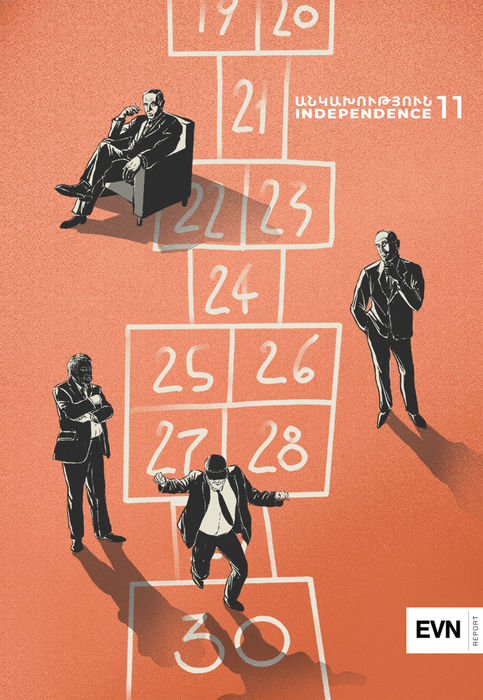
EVN Report’s 11th magazine issue “Independence” looks back over the four administrations of independent Armenia, revealing their major challenges and hurdles, their setbacks and successes. As such, it covers Armenia’s first President Levon Ter-Petrosyan (1991-1998), second President Robert Kocharyan (1998-2008), third President Serzh Sargsyan (2008-2018) and Prime Minister Nikol Pashinyan (2018-2021).
The Levon Ter-Petrosyan Administration: 1991-1998
By Hovhannes Nazaretyan
Independent Armenia’s first president was Levon Ter-Petrosyan. This article chronicles his rise to power and the major challenges and shortcomings of his administration.
The Robert Kocharyan Administration: 1998-2008
By Lusine Sargsyan
Independent Armenia’s second president was Robert Kocharyan. This article chronicles his rise to power and the major challenges and shortcomings of his administration.
The Serzh Sargsyan Administration: 2008-2018
By Astghik Karapetyan
Independent Armenia’s third president was Serzh Sargsyan. This article chronicles his rise to power, the major challenges and shortcomings of his administration and his eventual resignation.
The Nikol Pashinyan Administration: 2018-Present
By Gohar Abrahamyan
Armenia’s current Prime Minister came to power in 2018 following nationwide protests. This article chronicles his rise to power, the major challenges and shortcomings of his administration.
Diaspora | N6
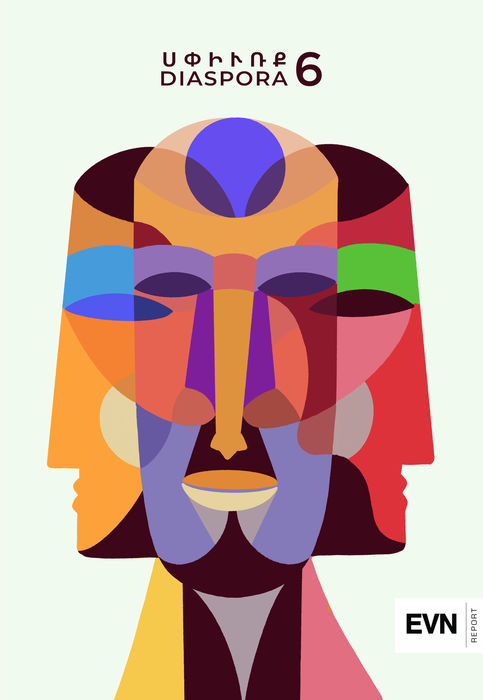
EVN Report’s April issue “Diaspora” focuses on the realities of the Armenian diaspora and attempts to understand the multi-layered, multi-dimensional nature of the ever-changing Armenian diaspora. Today, in the post-war reality, it is important to redefine and recalibrate the relationship between Armenia and its diaspora.
Post-War Reflections From the Diaspora
By Lalai Manjikian
The diaspora must continue to invest in rebuilding and channeling diasporic potential following the 2020 Artsakh War. This is not 1915, writes Lalai Manjikian, the nation has a huge pool of educated, driven and competent forces.
A Defining Moment for the Armenian Diaspora? Some Preliminary Reflections
By Sossie Kasbarian
The 2020 Artsakh War was perceived and experienced in Armenia as well as in the diaspora as an existential crisis. Kasbarian argues that the recent nation-wide mobilization made this moment a transformative one.
Diaspora Conceptualizations and the Realities of the Armenian Diaspora: Some Preliminary Observations
By Vahe Sahakyan
Do diasporas have agency, imagined and conceptualized, to produce collective behavior or are they too vast and heterogeneous to generate any coordinated collective action in unison?
Ground Zero: Back to the Question of the Diaspora
By Khatchik DerGhougassian
Will the 2020 Artsakh War be a turning point for the diaspora to reassess and define a new agenda for itself? Dr. Khatchik DerGhougassian argues that a paradigm shift has started to occur in how the diaspora sees itself and its relationship with the homeland.
The Terrain of “Living” Western Armenian Literature
By Vartan Matiossian
Western Armenian literature does live in many different environments, traditional or innovative. The question, however, is in what conditions or with what prospects? New pathways are necessary to keep it “living.”
Comments
Harut Sassounian
9/26/2021, 8:05:45 PMTigrane, you have written an excellent analysis. I appreciate the great time you have spent in preparing this article. The article is quite long so I hesitate to add more content to it, but I would like to bring to your attention the following missing points: 1) Armenia did allow citizens who live abroad to cast their votes at Armenian Embassies and Consulates in presidential elections during Kocharian's first term. But when the majority voted for Kocharian's opponent, he got rid of that voting option. I suggest that such voting rights be reinstated which Pashinyan has not done. 2) A bolder option to integrate the Diaspora is to give them the right to vote in Armenia's elections. 3) You also did not mention that Armenia should allow Diaspora Armenians to assume high level or ministerial positions in the Armenian government by changing the laws that block such a possibility. Pashinyan has repeatedly spoken about this, but has not done anything about it. 4) I wish you had mentioned my committee's efforts to establish a Diaspora Armenian Parliament (see HyeID.org). This would solve many of the issues and problems you have suggested. Harut Sassounian President HyeID.org
Anna Harmandarian
9/26/2021, 4:29:14 PMThe macro struggles between Russia and the West have always been reflected on a micro level in Armenia, having translated into discriminatory attitudes between various components of the Diaspora. The very fact that Western Armenian was not given a “special” status until now, speaks volumes. In order to create an atmosphere of welcoming, there needs to be a recognition of the first wave of Diaspora repatriation after WWII. Filled with dreams, these were people to came to Armenia to help rebuild the homeland, only to be treated as second class citizens and to be called “Axpars” for generations. They would only fit in by assimilation and reneging of their Western Armenian heritage. In addition to this, though most we’re multilingual, they did not speak Russian. This latter fact relegated them to a second class status not just because it was the Soviet Union, but because Russianized Armenians were deemed superior due to centuries of cultural indoctrination. As a former part of Imperial Russia, in Armenia proper it was the Russian culture was the dominant , whereas the West was the dominant paradigm for most Armenians coming from the Middle East and elsewhere. An honest discussion of the contributions to Armenia of these early repats and their difficult lives— including the Gulag— is key to educating the population that contribution by all types of Armenians is nothing new and that no one group is “better” than the other. Framing this conversation as a focusing on the contributions of all Armenians, rather than an East/West conversation will shift the focus away from the uncomfortable discussions of Russian versus Western hegemony —especially at this time, and place the conversation square on us. No matter who your neighbors are, it is imperative to see all Armenians as equal and not just when they are donating money or doing fantastic deeds.


